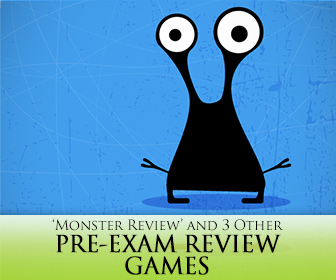Ahhhh, Exams!: 'Monster Review' and 3 Other Pre-Exam Review Games


Many students are very shy about using English, worried about their grammar, accent, or many other mistakes. Because fluency is so important for daily communication in any language, we as teachers need to find some way to get them talking. Reward systems and tying class attitude and behaviour scores to participation certainly helps address this problem, but forced participation is never as productive as when participation voluntary. To this end, it is worth the teacher’s time to use speaking activities that get the students excited and participating for that reason instead of coercion.
Games are one of the best ways to accomplish voluntary participation, even among the lower level and shy students. Adding an element of competition, especially on an individual basis, encourages students to try their best and helps them lose their inhibitions around speaking English in front of their peers. So here are three tried and tested speaking games that have proven to be effective and a ton of fun.

This activity only really works for topics in which there are specific answers for specific questions or specific responses to certain situations. Some preparation is required on the part of the teacher. Create a set of question/situations and the correct answers/responses. For a class of 30 it’s best to have 15 of each. Print four or five sets of these (more for advanced classes) and cut them up so that each question, situation, answer, or response is on its own small slip of paper. Be sure that you keep them in sets (ie. one full set of answers and one full set of questions – not all the questions in one pile and all the answers in the other).
In class, hand out one set of answers and one set of questions. Students then circulate and try to find the counterpart to their card. When they do, they find a teacher and read out the question and response as a dialogue. If they are correct the teacher marks each of their slips (the students keep the completed slips) and hands them two new slips from the next set of questions and answers. Students then go and try to find a match for their new slips. Mark the slips to make sure students do not try to use the same slip to match with several different people. The marks also serve as points. Continue this process for either a set time limit or until all of the slips have been handed out. When the activity is over the student with the most marked slips is the winner.
For higher level classes, stipulate that all communication when trying to find their partner must be done in English.
This game requires very little preparation on the teacher’s part. All that is really needed is four increasingly complicated dialogue pieces. To help with student clarity, I either draw a pyramid on the board, or have one on a presentation slide. Divide it into four levels. Each level is associated with a two or four line piece of target language that the students have learned in the unit. From the bottom to the top they should be easiest to hardest. All students start at the bottom and must work their way up. They do this by finding another student on their level and going through the dialogue together. If one student can’t complete their part of the dialogue they remain on that level and their opponent advances to the next level. If they both successfully complete their half of the dialogue, they play rock, paper, scissors to decide who advances. Once they have completed all four levels , they come and find the teacher. The teacher can ask them any question from the entire unit, or preceding units for high level classes. If the student gets it correct they play rock, paper, scissors against the teacher. If the student wins they are a winner. If they lose they go back to the bottom level. Continue the game until you reach a pre-set number of winners.
Some versions of this game associate each level with an animal or action. The students who are on that level must act like the animal so they can locate one another.
To extend the amount of time this game takes, the loser of each battle can go down a level. Also, if a student playing rock, paper, scissors against the teacher loses, the entire class goes back to level one.
This game can be very difficult to monitor, as the students are all over the classroom and all talking at once. One method to help with this is to have the students police themselves. Tell them that if they see pairs playing rock, paper, scissors without first completing the dialogue they can tell you and you move the students down a level and require them to complete a dialogue set in front of you to advance. Also, emphasise that if one person cannot complete the dialogue then the other person advances without any need to go through the rock, paper, scissors process.
Students seem to appreciate the element of luck that rock, paper, scissors introduces into this activity.
This game is one that works especially well for low level classes as it does not require using English freely. The teacher must prepare a presentation with one sentence on each slide. I usually create a conversation based on the topic and using the dialogue the students have most recently learned. Ideally, use relatively short sentences. If you can get several one or two word responses in there it keeps the students on their toes. To make things more interesting you can add several other picture slides between the sentence slides. One is simple an ‘out’ slide. If a student gets that slide on their turn they are out. One is a slide that does not affect the student that gets it but the one who is next. If that student is still in the game, then they are out. If they were already out then they are in. The final kind is a random action (make kids jump and say something or whatever). They must do it within five seconds or they are out. Whatever you do, you will need at least one slide per student with a few extras.
Once in class, have all students stand up. Set an order among them. When each student’s turn comes they have the choice of reading one or two words from the sentence on the screen. Not more or less. Whoever is forced to read the last word of the sentence is out. Depending on what other slides you have included, there is also a sense of randomness whenever you change the slide. Keep going until there is only one student still standing. They are the winner.
I usually tell them there will be a game if they are well behaved and participate and that increases the speaking level even before the game comes out. Be aware that all of these games can get a bit noisy as the excitement builds. Frankly, that’s part of the fun and it’s what helps the kids forget their inhibitions. So, try one out and enjoy the laughter!